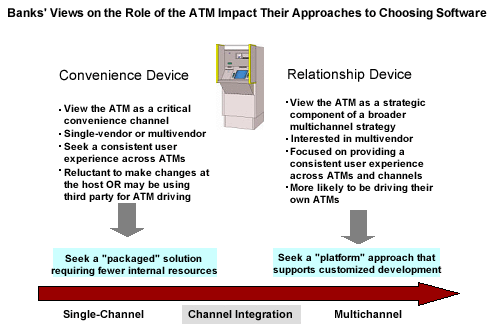Next-Generation ATM Software: From Multivendor to Multichannel
Abstract
ATMs are increasingly running on next-generation multivendor software that allows financial institutions to deploy advanced functionality and improve the user experience.
Today's ATM market is shifting toward more open architectures, as marked by the rapid adoption of a common operating system (i.e., Windows), the emergence of multivendor software supporting interoperability, and a move toward IP-based networks. This shift is resulting in the increased commoditization of ATM hardware and is enabling significant advancements on the software front--heralding a period of innovation at the ATM which remains a critical but largely underutilized delivery channel for banks. However, this change is also requiring banks to implement new tools and tactics to manage a more open and more complex technology environment.
In a new report, , Celent estimates that 22% of ATMs globally are currently running next-generation multivendor (i.e., XFS-based) software, a figure that is expected to rise to 37% by 2009. The report provides an overview of multivendor software available on the market and identifies banks' key criteria in making the software buying decision, particularly at how banks' perception of the role of the ATM impacts their approach to choosing software.

Celent also identifies strategies being pursued by various financial institutions to modernize their ATM architectures and highlights key benefits and challenges that banks are experiencing as they migrate away from a non-proprietary ATM technologies. Key benefits include an improved customer experience, ease of innovation, and the decoupling of the hardware and software purchasing decisions, while challenges include more complex change management, security, support and testing requirements.
"Looking beyond the ATM channel, the move to open architectures is also providing banks with greater flexibility in integrating their self-service channels with other banking applications. Best practice financial institutions that view the ATM as a relationship device rather than merely a channel of convenience are thinking beyond the concept of multivendor software and are tackling the challenge of better integrating the ATM within the enterprise, resulting in the emergence of a next-generation self-service architecture based on the principles of service-oriented architecture," says Madhavi Mantha, author of the report and senior analyst.
The report includes an in-depth case study of Landesbank Baden-Wuerttemberg (LBBW), Germany's fifth largest bank, that has successfully tackled the challenge of integrating its self-service channel within a broader cross-channel platform built using the principles of SOA.
The report is 36 pages and contains seven figures and five tables. A table of contents is available online.
Members of Celent's Retail Banking research services can download the report electronically by clicking on the icon to the left. Non-members should contact info@celent.com for more information.
